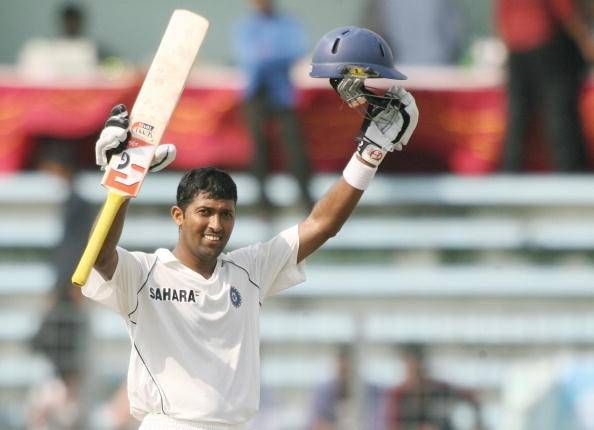
Indian cricket's perennial outsider - The story of Wasim Jaffer

On 8 November 2015, there is a Ranji Trophy match going on in Kolkata. Vidarbha are playing Bengal. It's just another game of cricket. It should mean much more to one man, but it doesn't.
Wasim Jaffer is playing for Vidarbha. He makes scores of 9 and 3. There's nothing worth looking back upon. Except that the 9 contains his 10,000th run in the Ranji Trophy. And he's the first man to get there.
It's probably the first time he's right there, at the centre, on top of a mountain nobody has climbed, in the limelight. Except that the mountain is invisible and there is no limelight.
That's how his life, his career has panned out. As an aside, as the side show. The perennial outsider.
This feat, as great as it is, hardly gets any coverage. There's virtually no one present at the venue. Those who read about it wonder when he left Mumbai.
There's no celebration. Jaffer hardly smiles on the cricket field. It's no different this time. Maybe, 10,000 is just another number in the never ending book of Wasim Jaffer.
****
In March 2006, Wasim Jaffer hits his first test century against England at Nagpur. It's just his eighth test. His first one was six years earlier. He has already been dropped twice. A stop-start beginning. Devoid of any momentum or rhythm.
But this time, he makes his mark. And begins what will be an uninterrupted run of 24 test matches. His time in the sun, yet away from it.
He follows this first century with more substantial, much more important innings. And it includes two double centuries, absolutely magnificent ones. The first is against the West Indies at Antigua and the second against Pakistan at the Eden Gardens.
For most batsmen, these are occasions to rejoice, to experience unparalleled happiness. For Jaffer, it was just another score, just another match. No fanfare. No celebration. Just a customary wave of the bat.
That's just how Wasim Jaffer was. Quietly brilliant, almost invisible. Always an outsider.
****
Apart from those doubles, there were more important innings that he played. On the tours to South Africa and England during 2007 in particular. But he was always overshadowed. He was the Toyota to the Porsche. The Paul McCartney to John Lennon. The Houston to California.
No matter how good he was, there was something bigger, something better. Always.
And it couldn't have been truer as the end came. The tour to Australia, the one of 'Sydneygate' and the Perth victory, was the beginning of Jaffer's end. Out of the six innings he played, Brett Lee got him five times. It was painful to watch a batsman being torn apart so mercilessly, so badly.
And this was perhaps the only time that Jaffer was noticed by people. To borrow a line from Jarrod Kimber, he "deserved to be remembered for how he stood, not how he fell". The next series, against South Africa at home, turned out to be Jaffer's last. Two bad series, five bad tests, and he was axed forever. It's a fickle world. It's a fickle life.
As was mostly the case with him, in the eyes of others, the selectors, the people, there was always something bigger, something better than him.
He went just the way he came, just the way he played. In complete obscurity.
****
Jaffer returned to domestic cricket. And he scored a mountain of runs. Just the way he always had. Here, in the small circle of Indian domestic cricket, Jaffer was recognized, he was respected. Here, he was a legend.
Season after season, he topped run-scoring charts for Mumbai, winning them many a title on the way. Out there, in the many empty Jadavpur Universitys, the many lifeless Wankhedes, the many silent Sawai Man Singhs, Jaffer lived his best years. Climbing that invisible mountain.
There should have been a recall to the national side. His name even came up in 2012 and 2013. But there wasn't. For, in our eyes, there was always someone bigger, someone better. An IPL star. A young gun. A dazzling stroke maker. Things that Jaffer wasn't.
We only remember, we only know things that Jaffer wasn't. For our eyes were too blind to notice what he was. They still are. They forever will be.
Considering that Jaffer played most of his cricket abroad, he had a more than decent record. 31 tests, 1944 runs. 5 centuries and an average of almost 35. But for a man with a domestic career as supremely amazing as his, it seems that he didn't do justice to his run-scoring capabilities.
Looking back, we'll say that there was something bigger, something better.
And we'll again be too blind to notice the role he was supposed to play in the team, of playing out the new ball, of holding one end up. Too blind to notice how important his contributions were, too blind to notice how important he was.
Too blind to notice who he was.
****
Jaffer's batting was good to watch. Quite classy. More than that, it was effective, it was clinical, it was thorough. More determination than flair. More Graham Gooch than David Gower.
There's much more to it. There can be pages and pages which can be written on it. But this article was not meant to be about his batting. It was always meant to be about the journey of a man whom India failed to notice. The man who was there, yet not.
He was so much. He could have been so much more. He should have been so much more.
He deserved to live his best years, in the limelight, in packed stadiums in the different cities of the world, as a great Indian test match opener.
Instead, despite his staggering domestic record, he remained Indian cricket's perennial outsider.